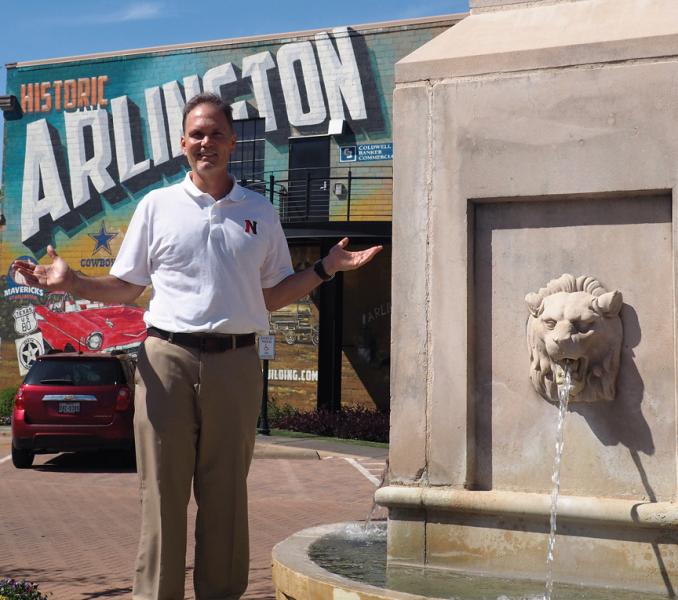
Arlingtonites tend to be a disinterested bunch,
which is to say that when not driving – and sometimes when they are – they tend to be more interested in texting or otherwise fiddling with their smart phones than anything else. What’s to see, after all?
Yet, slap down 540 tons of granite sculptures that is Caelum Moor around a pond at Richard Greene Linear Park, and they shed their recalcitrance to utter more than a few “Wows.”
Show up with 54 feet of metal sculpture on Abram Street that stands 12 feet tall and spells out the word “Dream” in keeping with Arlington’s “Dream City” brand, and it’s time to stop and maybe shoot and share a few pictures with the aforementioned smart phone. Create a new sculpture trail sprinkled with eye-catching futuristic works along Johnson Creek, and the path suddenly fills with curious hikers, cyclists and dog walkers. And tourists.
Call it public art, which suddenly seems to be the emerging fashion in Arlington.
About time, too.
Darryl Lauster, associate professor of sculpture at UTA, recalls that after accepting a new job at the university 10 years ago he and his wife decided to take a drive around town to check out the public art scene.
“There was virtually nothing. Nor did Arlington have the feel of a college town, which is typified by the presence of public art, restaurant ambiance and night life.”
Much has changed and continues to change, Lauster says, with the explosion of public art in the city – defined as free and accessible to the public – now being evident. That unique art of Arlington takes all kinds of forms:
Historical, patriotic, whimsical or religious sculptures. Strange and entertaining metal works. Kinetic pieces that move in the wind. Giant wall murals that reflect everything from Arlington’s days as a gambling haven to Texana themes.
Modernist mustangs reflecting the Maverick theme decorate the UTA campus. Twenty giant stars created by 20 different artists have popped up at intersections throughout the city. A mix of local, state, national and international artists have all contributed to a collection of avant-garde sculptures along Richard Greene Linear Park.
“It’s an epidemic of public art but in a very good and healthy way,” says Chris Hightower, executive director of the Arlington Museum of Art and one of the originators of the Stars of Texas project.
So much has happened in Arlington
so quickly in the public art genre that it almost seems as if there’s a giant master plan for it. There isn’t. Each independent project becomes a sort of catalyst for yet another unrelated project, but somehow it all seems to be working. Hightower, for example, found himself frustrated with so many people being unaware of the variety and quality of exhibitions at the Arlington Museum of Art on Main Street. “So I flipped the idea,” he says. “In addition to bringing people to the museum I wanted to take the museum to them.”
Figuring that a star was a component of so many logos in Arlington and Texas – from the city to the Cowboys to the state flag – Hightower obtained 20 oversize stars and commissioned artists to use them like a canvas, their works to be distributed at high traffic locations everywhere. Vandergriff Offices owner and local Coldwell Banker owner Gary Walker converted an old auto dealership building with mundane architecture into offices but wanted a way to make the property located at 255 N. Center St. unique. He’s done so with a collection of public art in the parking lot/courtyard, ranging from a model of the city’s old mineral well and massive steel sculpture to an eye-catching wall mural that reflects on Bankhead Highway-Division Street history.

“I can’t really quantify what the payback is or even if there will be a payback,” Walker said of his art investment, “but I just like the look and think it makes the building unique. A memorable sense of place.”
Walker recently bought a 1952 Chevrolet Bel Air – the building was once a Chevy dealership – and is contemplating having artists use the body as painting palette. Then the old car will join his public art collection, possibly on the roof.
In Arlington it seems
one public art project encourages others, all working independently. The Sculpture Trail between Globe Life Park and AT&T Stadium, for instance, will feature pieces that will be in place two to three years – leased art of a sort – and then be replaced by other pieces. The centerpiece of the Sculpture Trail, a “Unity Arch” commissioned to symbolize the “passion, dedication and unwavering spirit” of Arlington will be in place by June.
“Arlington becomes something of a different place when visitors see appealing public art as a component of their destination and when residents take note of it as an element of civic pride,” says sculptor Lauster. “This kind of art also enhances civil pride and enhances quality of life in a commemorative way. In this I’m seeing Arlington make a real transition.”
For an expansive overview of public art in Arlington go to pinterest.com and search for Arlington, Texas, public art.

















